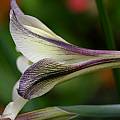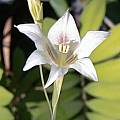Quick Characteristics:
| Height: | 45-80 cm (1.5-2.6 ft) |
| Flower Colors: | white, yellow |
| Flower Season: | early spring to mid spring |
| Life form: | deciduous corm |
| Climate: | winter rain climate, USDA Zone 8-9 |
Gladiolus tristis L. is one of the more widespread species in the winter rainfall regions. It is often found in dense colonies on damp flats, but can be found near sea level to high elevations. It is nicknamed the marsh Afrikaner and can be found in marshy areas, but also on banks above streams, in poorly drained seeps or on cool south-facing slopes. The time of bloom varies by populations. It produces a lot of little cormlets around the base of the corm and can spread to other pots if soil is reused. This species also spreads by seed, and has been known to naturalize in habitats it likes such as gardens and botanical gardens. It's not a thug, but be aware of what you're doing if you put it in the ground in a mediterranean climate. Plants grow to about 2 feet (~0.7m) tall with slender, spiraling leaves about the diameter of a chopstick. It is easily grown in a well-drained mix, full sun, and summer dry dormancy. Give it a dilute or slow release fertilizer high in phosphorous when in active growth.
Photos 1-2 were taken by Sheila Burrow, 3 by Doug Westfall, 4-5 by Alan Horstmann and 6 by Kathleen Sayce.
I grow two forms. One is light yellow and blooms March to April. It is only slightly fragrant at night. It is the first one pictured below. In the second photo there is a spider on the flowers, catching what seems to be a fly pollinator. The second form pictured below in photos 3-4 is a late blooming form, once known as Gladiolus tristis var. aestivalis, but not recognized as a variety by Goldblatt and Manning. These plants were grown from IBSA seed collected near Paarl where they grow in wet boggy areas that are shady. This form is very fragrant at dusk/night when the flowers are open wider as well. The last photo shows one corm on a 1 cm grid with all the cormlets showing how many new plants are possible from one corm. Photos by Mary Sue Ittner .
Habitat shots taken by Bob Rutemoeller September 2003 at Drayton and Cameron McMaster at Bredasdorp.












